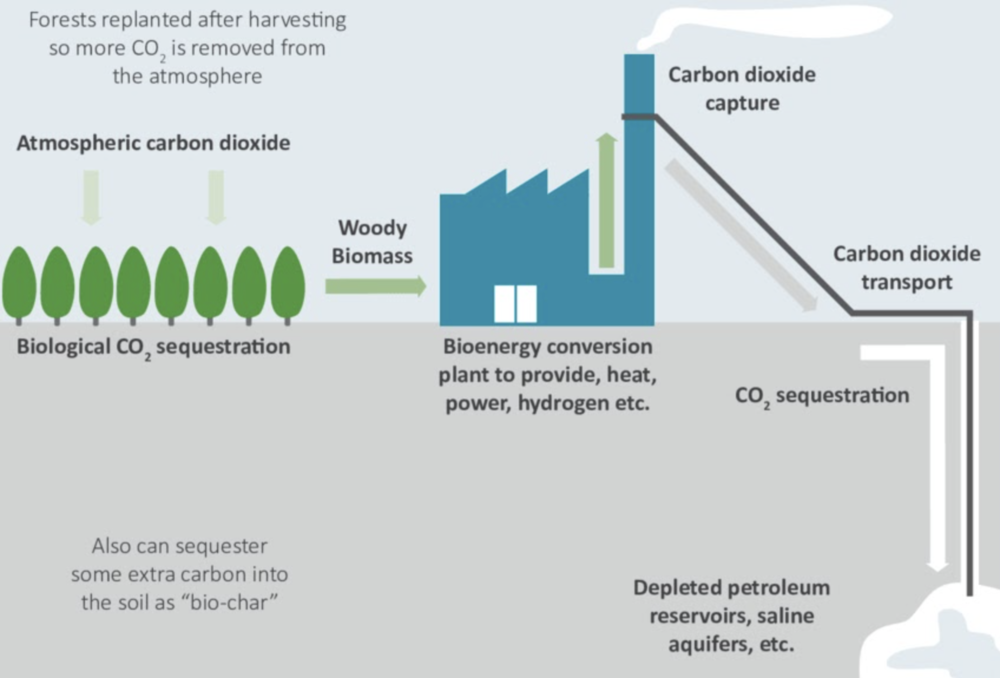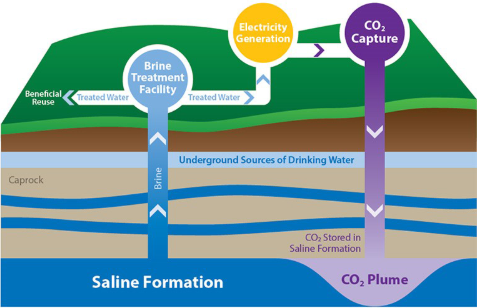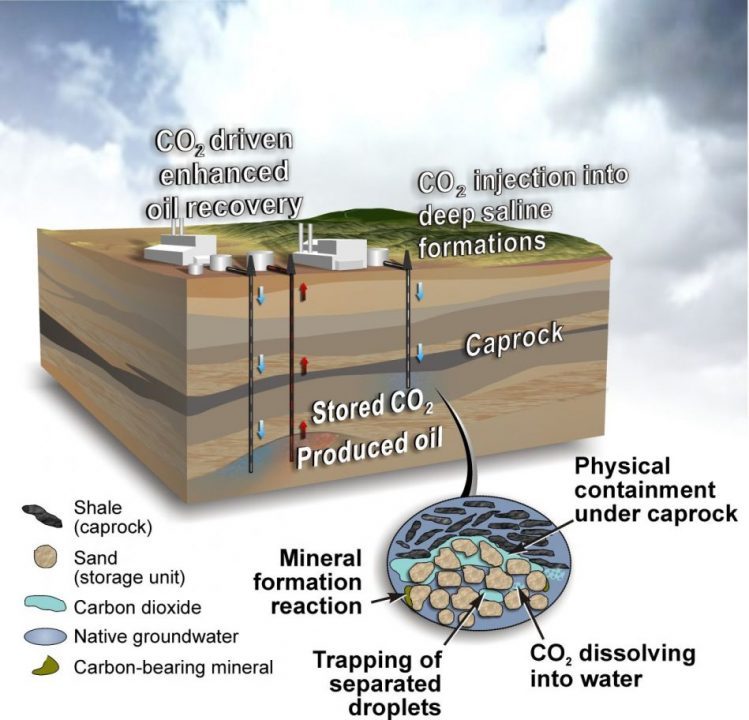Carbon Capture and Storage Requires Which of the Following Steps
Its a three-step process involving. And then storing it deep underground.

Preventing Climate Change With Beccs Bioenergy With Carbon Capture And Storage Psci
Carbon Capture Utilization Storage.

. It takes a lot of energy to re-capture the CO2. Any technique that prevents or reverses the release of CO2 to the atmosphere and diverts the carbon to a viable carbon sink can be considered carbon capture. CCS is a three-step process that includes.
Carbon capture utilisation and storage or CCUS is an important emissions reduction technology that can be applied across the energy system. For the Carbon capture and storage method this period is up to 5 years. Carbon Capture and Storage CCS is a way of reducing carbon emissions which could be key to helping to tackle global warming.
Injecting carbon dioxide in a rock formation near an area of salty water. There are four ways to acquire the right to inject carbon storage into a subsurface. To better understand the industrial inputs and timeline of carbon capture projects here is a general outline of a Carbon Capture Utilisation and Storage Process CCUS from start to finish.
Injecting carbon dioxide into a rock cap and the small gaps between the rocks trap carbon dioxide. A portion of a coal plant used for carbon capture. Carbon capture and storage is a suite of technological processes which involve capturing carbon dioxide CO 2 from the gases discarded by industry and transporting and injecting it into geological formations.
The technology can capture up to 90 of CO 2 released by burning fossil fuels in electricity generation and industrial processes such as cement production. Carbon dioxide CO 2 capture and sequestration CCS is a set of technologies that can greatly reduce CO 2 emissions from new and existing coal- and gas-fired power plants and large industrial sources. Despite each step of carbon capture and storage being well understood the combined technology remains relatively expensive with costs estimated between 50 and 100 a.
1 easements and surface use agreement from the owner. Under the method all projects will have a 25-year crediting period. Historical examples of CO 2 separation if scaled-up could consume 25 to 40 of the fuel energy of a power plant and be responsible for 70 or more of the additional costs in CCS 8.
This prevents the carbon dioxide from entering the atmosphere reducing the impact these. The crediting period is the period of time a project can apply to claim ACCUs. A typical CCUS process involves the following steps.
Over time carbon dioxide will go in the water making the water more dense. GCEP Carbon Capture Technology Assessment Spring 2005 5 emitted from cement production contain 14-33 mole fraction CO2 due to the combustion of fossil fuels for heat and CO2 production from calcination 6. Carbon capture utilisation and storage process.
The CO 2 gas is then compressed. Such strategies include the facilitated capture and storage of carbon dioxide through sequestration using plants or by physical capture from major sources and injection into geologic formations. The CO 2 is transported along a pipeline to a suitable geological site.
Carbon Capture and Storage CCS Carbon Capture and Storage CCS processes remove carbon dioxide CO 2 that would otherwise be emitted from fossil fuel power stations and other industrial processes and transport it for permanent underground storage. CCS enables industry to continue to operate while emitting fewer greenhouse gases CHGs making it a powerful. Carbon capture and storage CCS is the separation and capture of carbon dioxide CO 2 from the emissions of industrial processes prior to release into the atmosphere and storage of the CO 2 in deep underground geologic formations.
The Department of the Interior has a long history with injecting carbon dioxide into geologic formations. Dynamic simulation for CO2 injection. The CCS method allows a longer period between project registration and the crediting period starting than many other methods.
Carbon capture and storage CCS is a range of technologies that hold the promise of trapping up to 90 of the carbon dioxide emissions from. Second the value of captured CO 2 emissions must increase through new uses and sources of demand. This will make the water sink more which traps carbon dioxide in the process.
The CO 2 is separated and captured at an industrial natural gas oil coal or biomass facility. Reducing the Costs of Carbon Capture. Permitting and Land Use.
Remember where that CO2 comes from. Carbon mineralization is a versatile and thermodynamically downhill process that can be harnessed for capturing storing and utilizing CO2 to synthesize products with enhanced properties. CO 2 can be captured using different methods.
Acquiring Carbon Storage Rights. Transport of the captured and compressed CO 2 usually in pipelines. In Great Britain GB storage of CO 2 will only take place offshore in saline formations or depleted oil and gas fields.
The CO 2 is injected deep below the ground for long-term storage. Separation of CO 2 is the step that consumes the most energy and results in the highest cost. First the cost of capturing carbon must come down either through the development of new technologies or through scale and experience effects.
Carbon capture utilization and storage CC U S also referred to as carbon capture utilization and sequestration is a process that captures carbon dioxide emissions from sources like coal-fired power plants and either reuses or stores it so it will not enter the atmosphere. Carbon capture and storage CCS is the process of capturing and storing carbon dioxide CO 2 before it is released into the atmosphere. CCUS technologies involve the capture of carbon dioxide CO2 from fuel combustion or industrial processes the transport of this CO2 via ship or pipeline and either its use as a resource to create valuable products or services or its.
Carbon dioxide storage in geologic formations includes oil. Carbon Capture and Storage Carbon capture and storage CCS or carbon capture and sequestration or carbon control and sequestration is the process of capturing waste carbon dioxide CO 2 from large point sources such as fossil fuel power plants transporting it to a storage site and depositing it where it will not enter the atmosphere normally an. A CCS chain consists of four parts.
Capturing the carbon dioxide produced by power generation or industrial activity such as steel or cement making. Carbon capture and storage sometimes referred to as CCS is a process that can take up to 90 of the carbon dioxide emissions produced from the use of fossil fuels in electricity generation and put them underground or under the ocean. First CCS requires a lot of additional energy to remove CO2 from power plant exhausts and even more from the atmosphere.
Carbon capture and storage CCS is a combination of technologies that capture CO 2 and then safely stored it underground in suitable geological formations. When we burn hydrocarbons natural gas coal or oil we release a lot of energy along with water vapor and CO2.

The Basic Principle For Carbon Capture And Storage Ccs Download Scientific Diagram

Carbon Storage Faqs Netl Doe Gov

How Carbon Capture Works Howstuffworks

What Is Carbon Capture And Storage Technology And How Does It Limit Co2
:max_bytes(150000):strip_icc()/carbon-capture-and-storage-5119849_final-fe5e59998bab4454a0c5cd7426ed64a6.gif)
.jpg)


No comments for "Carbon Capture and Storage Requires Which of the Following Steps"
Post a Comment